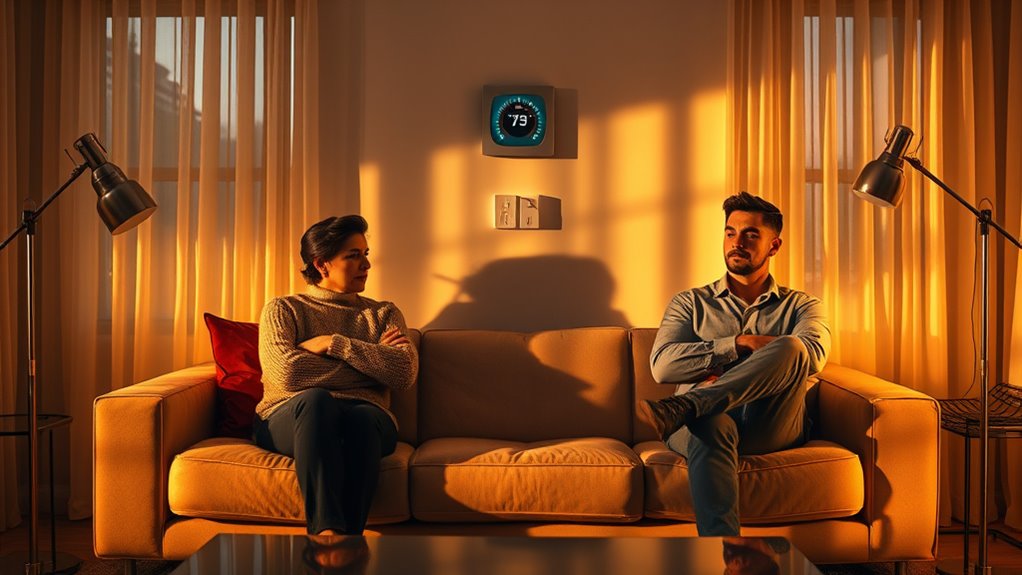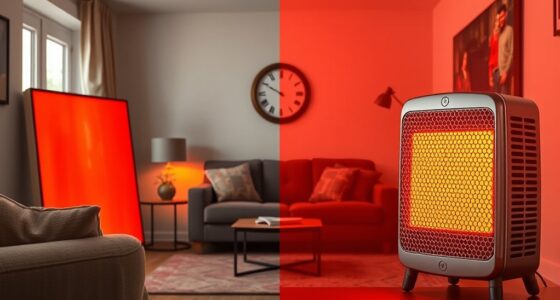You and your partner likely argue over thermostats because each of you has different comfort zones, influenced by physiology, activity, and clothing. What feels ideal for one might be too hot or cold for the other. These personal preferences create conflicts, especially if only one thermostat setting is used. Understanding these differences and exploring flexible solutions can help, and there’s more to learn about balancing comfort and energy use that could help ease these disagreements.
Key Takeaways
- Different personal comfort preferences cause disagreements over ideal thermostat settings.
- Variability in comfort zones leads to conflicts when trying to satisfy both partners.
- Energy efficiency concerns influence couples to prefer different temperature adjustments.
- Communication and smart thermostat technology can help mediate differing comfort needs.
- Balancing individual preferences with shared goals fosters harmony and reduces thermostat disputes.

Understanding thermal comfort zones is essential for creating environments where people feel neither too hot nor too cold. When you’re trying to find the perfect temperature, it’s easy to overlook how much personal preferences and energy efficiency play a role. Everyone’s comfort range is different, and that can lead to disagreements, especially when thermostats are involved. Recognizing these differences and learning how to balance them can help prevent conflicts and make your home more comfortable for everyone.
Personal comfort varies; balancing preferences and energy efficiency helps prevent thermostat conflicts and enhances home harmony.
Your personal preferences influence how you perceive temperature. Some people feel comfortable at 72°F, while others prefer 68°F or even 75°F. These differences aren’t just about personal taste—they’re rooted in physiology, activity levels, and even clothing choices. When you set the thermostat based solely on your preference, others in the household may find it too cold or too hot. That’s where understanding thermal comfort zones becomes essential. It’s not just about one person’s comfort; it’s about managing a shared space where multiple preferences collide.
Energy efficiency is another key factor. When you set the thermostat too low in winter or too high in summer, you might save money in the short term, but it can lead to higher energy bills and unnecessary strain on your heating or cooling systems. Finding a middle ground that aligns with your personal preferences while maintaining energy efficiency is a smart approach. For example, raising the temperature slightly in winter or lowering it in summer can make a significant difference in energy consumption without sacrificing comfort too much.
To manage these differences, communication is indispensable. Instead of sticking rigidly to one setting, try to understand each other’s comfort zones. If you and your partner prefer different temperatures, consider using smart thermostats that allow for individual control or setting schedules that accommodate both preferences at different times of the day. This way, you can optimize for energy efficiency while respecting personal comfort. Small adjustments, like wearing layers or using fans, can also help bridge the gap between personal preferences and energy-saving goals.
Ultimately, understanding thermal comfort zones isn’t about finding a perfect temperature for everyone—it’s about balancing individual needs with energy efficiency and shared living. Being aware of how personal preferences influence comfort and the importance of energy efficiency can help you make more informed decisions. By making intentional choices, you can reduce conflicts over the thermostat and create an environment that feels good for all. This approach not only saves energy but also fosters harmony and respect in your home, making it a more pleasant space to live in.
Frequently Asked Questions
How Do Personal Preferences Influence Thermal Comfort?
Your personal preferences influence thermal comfort because of factors like thermal adaptation and metabolic differences. You might feel comfortable at a certain temperature due to your body’s adjustment over time, while someone else may prefer it warmer or cooler. Metabolic differences also play a role; higher metabolism can make you feel warmer. These variations make it tough to find a universally comfortable setting, often leading to disagreements over thermostat settings.
Can Age Affect Individual Temperature Perceptions?
Age can definitely affect how you perceive temperature, due to age-related sensitivity changes. As you get older, your body might feel colder or warmer more easily, leading to different comfort needs. Generational differences also play a role, as each age group may have distinct expectations for comfort. Understanding these differences helps you and your partner find a middle ground, reducing conflicts over thermostat settings.
What Role Does Clothing Play in Thermal Comfort?
Imagine you’re in a medieval castle, yet clothing still impacts your comfort today. Your layering strategies and fabric choices are key. Thick wool keeps you warm, while lightweight cotton helps you stay cool. By adjusting layers and selecting breathable or insulating fabrics, you control your temperature. Proper clothing allows you to fine-tune thermal comfort, reducing disputes and helping you feel cozy no matter the thermostat’s setting.
How Does Humidity Impact Comfort Levels?
Humidity effects substantially impact your comfort levels by influencing moisture regulation in the air. When humidity is high, you may feel sticky and sweaty, making it hard to cool down. Low humidity can cause dry skin and irritation. Maintaining balanced humidity helps your body regulate moisture more effectively, preventing discomfort. So, controlling humidity levels ensures you stay comfortable, whether it’s too humid or too dry, improving your overall thermal comfort.
Are There Health Risks Associated With Temperature Disagreements?
You might wonder if temperature disputes pose health risks. Disagreements over the thermostat can lead to inconsistent room temperatures, causing stress and potential respiratory issues or temperature-related illnesses. Prolonged exposure to uncomfortable temperatures can weaken your immune system and increase your risk of colds or heat-related illnesses. To avoid these health risks, it is crucial to find a compromise and maintain a comfortable, stable environment for both of you.
Conclusion
So, next time you and your partner clash over the thermostat, remember it’s all about your individual comfort zones. While it might seem trivial, understanding that everyone has different thermal preferences can help you find common ground. Don’t dismiss these disagreements as petty — they’re rooted in genuine comfort needs. By communicating openly and compromising, you can create a cozy environment that works for both of you, turning thermostat battles into opportunities for connection.









